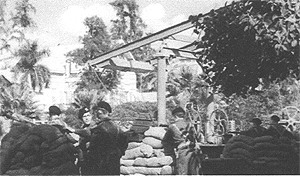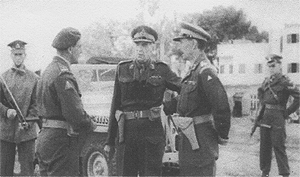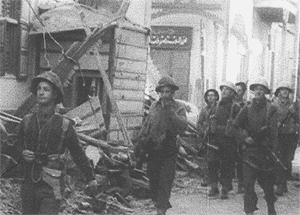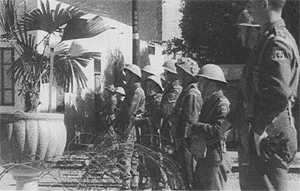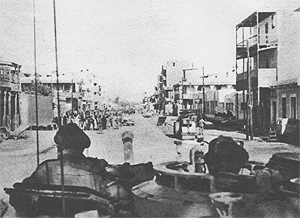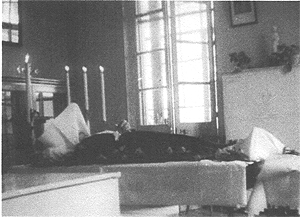“I AM not a martyr yet, but I
may well be one of these days.” In these prophetic words Sister
Anthony, the 52 year old St. Vincent de Paul nun who was murdered in Ismailia
last weekend told of her danger in a last letter to a member of the community
at Blandford Street Convent, London.
On Monday, the nuns at the London Convent where she
had lived and worked during the war years, received her letter. In it,
Sister Anthony spoke of the worsening situation and of the ever-present
possibility of martyrdom. Six days later, on Sunday, they learned from
a little girl in their school that the papers were already reporting that
she had been murdered the previous day in cold blood.
Born in the Bronx district of New York City in 1900, Sister Anthony
spent many years in Belgium after taking her vows as a religious of
the Congregation of St. Vincent de Paul. I was told by the Sister Superior
of the Mother House at Mill Hill, London, this week: “At various
periods she was a teacher at the Sisters of Charity school for the deaf
and dumb in Tollcross, Glasgow; at the Holy Family School, Liverpool,
and at St. Vincent’s Orphanage, Mill Hill. During the recent war,
Sister Anthony performed a variety of tasks at the Blandford Street
school, in London’s West End. The Sister Superior there said:
“She was a most versatile person, popular with everyone and of
a most lovable disposition. Her cheerfulness and readiness to see the
humorous side of any situation were a comfort to all of us when the
air raids made life uncomfortable.”
“The children she taught were always greatly attached to her,
and she kept in touch with some of them right up to the time of her
tragic death. One of the little tasks she personally undertook was looking
after the destitute old men who came round to the back-door of the convent.
She made a point of collecting cigarettes for them, and this gave her
particular pleasure.”
“Sister Anthony left for Ismailia about five years ago. But she
was a great letter-writer, and her final letter reached us last week.
In it she seemed already aware of the perils around her – and
resigned to anything that might happen to her.”
One of Sister Anthony’s former pupils wrote to the Blandford
Street school this week, expressing her sorrow at the news of the tragedy.
“I shall always be grateful” she said, “for the memory
of those happy days, for the excellent education, and for the solid
grounding in the Faith.” The writer admitted that girls seldom
realize the value of such spiritual benefits until later in life. And
she concluded: “I believe that great blessings will flow to the
Order as a result of Sister Anthony’s heroic death.”
Mr. John Ramsay-Fairfax, one of the many Catholic servicemen stationed
in the Suez Canal Zone during the war, described the Ismailia convent
as “an oasis of spiritual and bodily rest and refreshment to many
hundreds of Catholics among the Allied forces. Being ‘English-speaking’,
Sister Anthony quickly endeared herself to all those troops with whom
she came in contact, and I can recall how some of them arranged for
her to visit the Catholic church at Fayid.” “But it wasn’t
only the local British and French communities who had reason to appreciate
the kindness and generosity of her and the other nuns. I remember the
late Archbishop Hughes telling me of their strenuous and determined
efforts to start an infant school for the poorest of
the Egyptian Coptic poor who dwelt nearby.”
Men of the 16th Parachute Brigade in their red berets combed the Arab
quarter of Ismailia on Tuesday this week, continuing their prolonged
search for arms and suspects which might lead them to the murderers.
While they moved cautiously from house to house, General Sir George
Erskine, British Commander in the Suez Canal Zone, led the official
group of officers and men who knelt bareheaded in the garrison cemetery
at Moascar as Sister Anthony’s body was lowered into its temporary
grave.
General Erskine – who was present at the Solemn Requiem Mass
before the funeral in the neighbouring Church of the Holy Family –
knew the murdered nun well. His wife, Lady Erskine, was a close personal
friend. “She was a wonderful woman who was well know to all of
us” was General Erskine’s tribute. “It is a monstrous
thing that the people who profess to be fighting us should attack helpless
women.”
The Mother Superior of the convent, a small house with its own garden,
is Sister Yvonne Moran, one of the ten French nuns in a community of
12. It was Sister Moran who described the shooting in the garden, which
led up to Sister Anthony’s murder.
“All the afternoon terrorist kept coming into the convent grounds,”
she said. “The children were put in the cellar, and our native
boy went out several time to ask them to go away. Then five of them
rushed through with bombs in their hands; the fuses burning. Sister
Anthony ran out to stop them, shouting “No, no, no, you won’t
throw that!” But they pushed her aside and threw their bombs.
Then Sister Anthony phoned the British for help. Outside the terrorists
were screaming for someone to cut the telephone lines. As we heard the
tanks coming, I saw Sister Anthony begin to open the door. She had heard
the tanks and was going out to welcome them. Then there was a shot and
she was finished. She died on the steps. She was good and kind, a hard
worker, a very good sister.”
After clearing the area, British troops stood guard over the convent
while the body of Sister Anthony was laid in state, between flickering
candles, on a mahogany table. Soldiers, who remembered her friendly
smile as she walked daily to and from the garrison school, filed past
the body to pay their last respects.
A special British court of inquiry is now sitting, going through the
evidence about the murder. Although it is doubtful if Egyptian witnesses
will come forward, the military authorities are convinced from medical
evidence and from statements already taken down, that Sister Anthony
was shot by someone inside the convent grounds.
The Egyptian Government, which promised to conduct its own inquiry,
has alleged, through its Minister of the Interior, Fuad Serag El-Din,
that it was a Bitish bullet which killed her. The Minister also alleged
that both the Sister Superior and Sister Catherine had emphatically
denied that there were any Egyptians inside the convent before or at
the time of the outrage. The murder, claim the Egyptians, was a deliberate
act of “provocation” by the British to interest American
opinion in the Anglo-Egyptian dispute.
For their part, American diplomatic representatives on the spot are
carrying out an independent investigation. And Mr. Jefferson Caffery,
United States Ambassador in Cairo, has announced that “appropriate
action” will be taken when the full facts have been laid bare.
